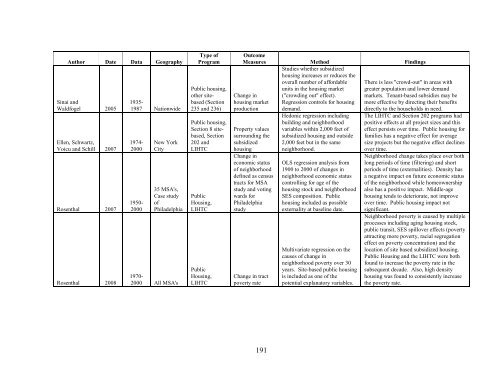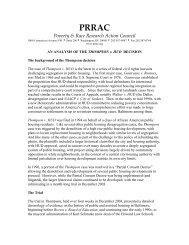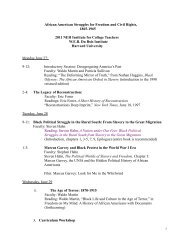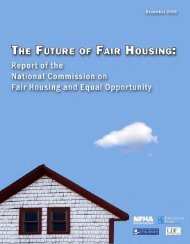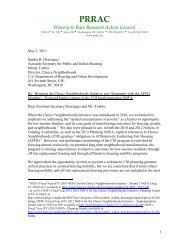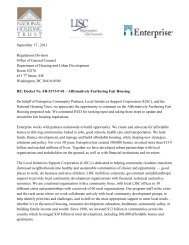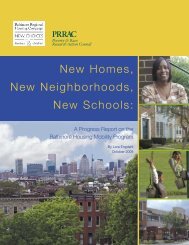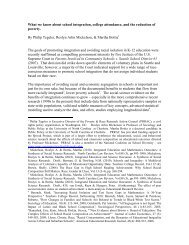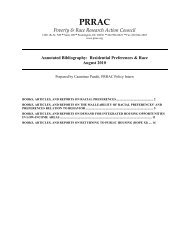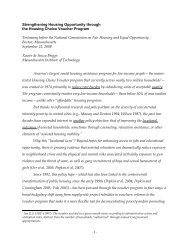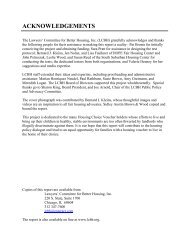The Spatial Concentration of Subsidized Housing - Poverty & Race ...
The Spatial Concentration of Subsidized Housing - Poverty & Race ...
The Spatial Concentration of Subsidized Housing - Poverty & Race ...
You also want an ePaper? Increase the reach of your titles
YUMPU automatically turns print PDFs into web optimized ePapers that Google loves.
Author Date Data GeographySinai andWaldfogel 2005Ellen, Schwartz,Voicu and Schill 2007Rosenthal 2007Rosenthal 20081935-1987 Nationwide1974-20001950-2000New YorkCity35 MSA's,Case study<strong>of</strong>Philadelphia1970-2000 All MSA'sType <strong>of</strong>ProgramPublic housing,other sitebased(Section235 and 236)Public housing,Section 8 sitebased,Section202 andLIHTCPublic<strong>Housing</strong>,LIHTCPublic<strong>Housing</strong>,LIHTCOutcomeMeasures Method FindingsStudies whether subsidizedhousing increases or reduces theoverall number <strong>of</strong> affordable <strong>The</strong>re is less "crowd-out" in areas withunits in the housing market greater population and lower demand("crowding out" effect). markets. Tenant-based subsidies may beRegression controls for housing more effective by directing their benefitsdemand.directly to the households in need.Change inhousing marketproductionProperty valuessurrounding thesubsidizedhousingChange ineconomic status<strong>of</strong> neighborhooddefined as censustracts for MSAstudy and votingwards forPhiladelphiastudyChange in tractpoverty rateHedonic regression includingbuilding and neighborhoodvariables within 2,000 feet <strong>of</strong>subsidized housing and outside2,000 feet but in the sameneighborhood.OLS regression analysis from1900 to 2000 <strong>of</strong> changes inneighborhood economic statuscontrolling for age <strong>of</strong> thehousing stock and neighborhoodSES composition. Publichousing included as possibleexternality at baseline date.Multivariate regression on thecauses <strong>of</strong> change inneighborhood poverty over 30years. Site-based public housingis included as one <strong>of</strong> thepotential explanatory variables.<strong>The</strong> LIHTC and Section 202 programs hadpositive effects at all project sizes and thiseffect persists over time. Public housing forfamilies has a negative effect for averagesize projects but the negative effect declinesover time.Neighborhood change takes place over bothlong periods <strong>of</strong> time (filtering) and shortperiods <strong>of</strong> time (externalities). Density hasa negative impact on future economic status<strong>of</strong> the neighborhood while homeownershipalso has a positive impact. Middle-agehousing tends to deteriorate, not improveover time. Public housing impact notsignificant.Neighborhood poverty is caused by multipleprocesses including aging housing stock,public transit, SES spillover effects (povertyattracting more poverty, racial segregationeffect on poverty concentration) and thelocation <strong>of</strong> site based subsidized housing.Public <strong>Housing</strong> and the LIHTC were bothfound to increase the poverty rate in thesubsequent decade. Also, high densityhousing was found to consistently increasethe poverty rate.191


